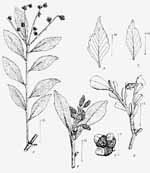Phyllocladus hypophyllus
Hooker 1852
Common names
Celery top pine (Filer 1991).
Taxonomic notes
Syn: P. hypophyllus Hooker var. protracta Warburg 1900; P. protractus (Warburg) Pilger 1903; P. major Pilger 1916. Type locality Mt. Kinabalu, Borneo (Van Royen 1979).
Description
Tree up to 30 m tall, bole up to 8 m, d.b.h. up to 60 cm; or a shrub 2-3 m high the tree line. Crown fairly wide spreading. Branches more or less whorled around main stem, much branched. Bark black, dark brown to reddish or grey, smooth and not peeling or scaly and rough, often with large pustular lenticels, breaking off in large, more or less rectangular scales. light brown within. Inner bark granular, pink or brown, with little orange milky exudate, weakly fibrous. Wood light brown, orange brown or brown, very hard, fragrant; sapwood light brown, yellowish red, white. Foliage: Foliar buds well developed, longer and less compact on younger plants, becoming more globular on older plants, enclosed by thin bracts. Juvenile leaves 5-8 mm long and adult scale leaves 2-3 mm long. Phylloclads dark green or yellowish green above and glossy, underside lighter, sometimes glaucous, variable in shape, on young plants deeply lobed and with distinct marginal hooks representing the reduced leaves, gradually becoming more compact, diamond-shaped to more or less oval with more or less wavy margins, 3-8 by 2-3 cm, the larger sizes mostly on young sterile specimens, marginal lobes c. 5 mm wide, often glaucous especially on the lower side, aggregated alternately on lateral branches of limited growth. Pollen cones usually produced on different plants than seed cones, each in the axil of a scale at the base of a growing shoot, in clusters up to 15, sometimes mixed with reduced cIadodes, yellow when young, mature ones red or pink, cylindrical, 12-15 mm long and 3 mm diameter with a naked peduncle 5-25 mm long. Microsporophylls oblong or squamiform, 1-2 by 1-1.5 mm, acute apex, irregularly toothed. Seed cones in an apical notch of a bilobed cladode or terminal on a reduced cladode or on a naked stalk c. 1 cm long, occasionally more than one together, ovoid and, like new cladodes, more or less purple, bearing up to 15 scales, of which usually 1-3 are fertile, becoming bright red when mature and then drying to a leathery brown. Seed shiny brown, 5-7 mm long (Van Royen 1979, de Laubenfels 1988). See García Esteban et al. (2004) for a detailed characterization of the wood anatomy.
Distribution and Ecology
Philippines, Borneo, Celebes, Moluccas, New Guinea. Grows in "moist mountain forests sometimes as low as 900 m up to tree line at 3200-4000 m" (de Laubenfels 1988). Based on data from 122 collection localities, its climate preferences include a mean annual temperature of 16.8°C, with an average minimum in the coldest month of 11°C, and a mean annual precipitation of 2813 mm (Biffin et al. 2011, Table S5). Zone 10 (cold hardiness limit between -1°C and +4.4°C) (Bannister and Neuner 2001).
Scattered in the forest at lower elevation where trees may be quite large. More common but of reduced stature at higher elevations. The lower elevation occurrences are apparently examples of the phenomenon 'temporary settlement' from established higher elevation populations as described by Van Steenis in his Mountain Flora of Java (1972)" (de Laubenfels 1988). In New Guinea, it is "a widespread and common species from the upper lowland forests to the subalpine shrubberies, rarely as a solitary tree in the alpine grasslands, 900-3600 m. Flowers the whole year round depending on local conditions" (Van Royen 1979).
Remarkable Specimens
No data as of 2023.02.21.
Ethnobotany
"The timber is used mainly for housebuilding purposes while the bark is regularly used for roofing" (Van Royen 1979).
Observations
No data as of 2023.02.21.
Remarks
The epithet hypophyllus means "below the leaves;" the rationale for this name is unclear.
"A National Park at Mt. Giluwe in the Southern Highlands Province [of Papua New Guinea] is proposed, including a mountain region of considerable beauty and exceptional botanical interest. ... The Park should be extended to include areas of forest dominated by Nothofagus grandis and N. pollei, locally known as 'Karapeh karapeh' and 'Karapah pu', and areas dominated by celery top pine Phyllocladus hypophyllus. The area is very rich in plant and animal species, including an unnamed giant Water Rat and six other Rat species" (Filer 1991).
Citations
Filer, Colin (Department of Anthropology & Sociology, University of Papua New Guinea). April 1991. Two shots in the dark: the first year of the task force on environmental planning in priority forest areas. http://lucy.ukc.ac.uk/lien/PNG/YEARONE.html">http://lucy.ukc.ac.uk/lien/PNG/YEARONE.html, accessed 2001.02.03, now defunct.
Hooker. 1852. Icones Plantarum v.9, p.889. Available: botanicus.org/page/1335218, accessed 2014.03.29.
See also





